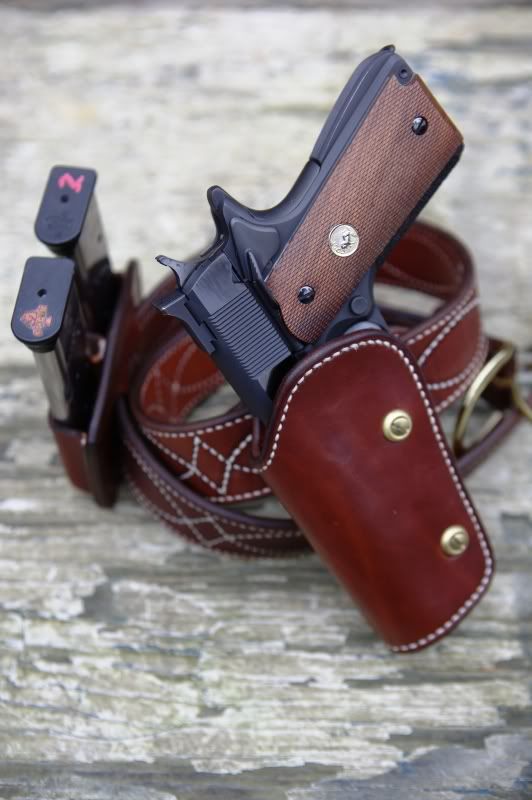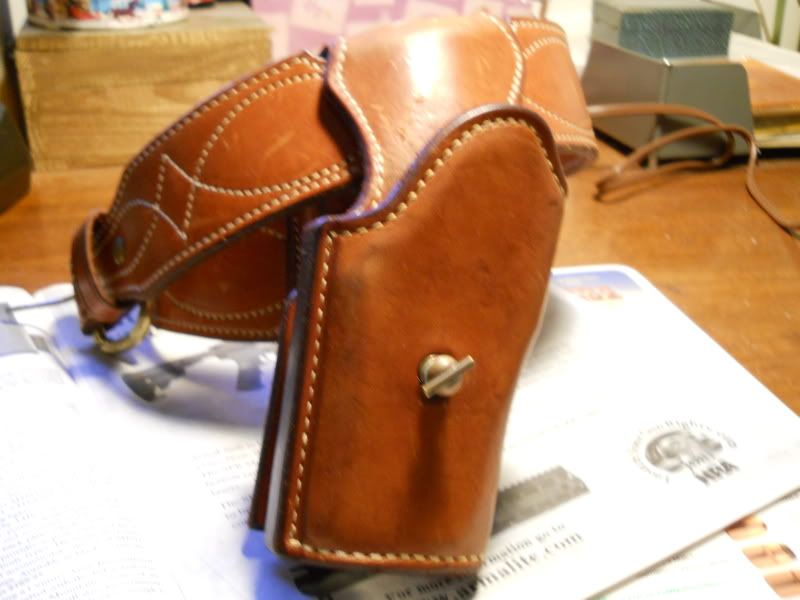
RickB
-
Posts
433 -
Joined
-
Last visited
Content Type
Forums
Profiles
Events
Store
Posts posted by RickB
-
-
I have a hi-cap Springfield .45, fed with Para mags fitted with Dawson pads and what I think are Grams followers. Early on, it was very difficult to get more than about fifteen rounds in the mags, and even that required pounding the mags on the bench to get a momentum assist on the last few rounds. Feeding was sluggish, with the rounds sort of oozing to the top, rather than snapping up, when a round was thumbed out. A local shooter, who's been competing with a P-14 in Limited for years, told me he pushes his cases all the way through a sizing die, so the rim is sized down to the same diameter as the rest of the case. Even though the .45 ACP case is "rimless", most cases will have rims in the .474"-.476" range, which is larger than the body diameter, making for rounds that are slightly tapered from one end to the other. This causes a lot of friction in a high-cap mag, because there are no ribs on the .45 tube, and the loaded rounds are in contact with the tube along their entire length. I loaded-up some of these truly full-length sized cases, and can easily load 18 by hand, and they feed much more smoothly. It's sort of a hassle, as I have to keep these cases separate from standard cases (zero extractor tension in my other guns, adjusted for typical rim diameter), but all my guns run better for maintaining supplies of the two types of case.
-
Regardless of what you call it, if you eject an empty mag, reload, and then rack out a round, it's PE time. You can't "fix" it by stowing the ejected mag.
You just made all tac reloads/RWR a procedural.
When is the slide racked during a retention reload? If there's been some sort of "clarification" that trumps the SO class materials of three or four years ago, then I'll concede. I know that rules have often been "clarified" in the direction of determining that there's no PE if the mistake is corrected before a shot is fired, but "rack out a round after ejecting mag onto ground = PE" was the rule.
EDIT: I'm addressing a situation in which the shooter thinks the gun is empty, but because the slide doesn't lock back, and they lost count, they perform a "slidelock reload" with the slide closed. Eject empty mag, insert full mag, rack slide to load, and because the gun wasn't empty, a round pops out. What's being argued here, is whether or not that can be "fixed" by THEN picking-up and stowing the mag on the ground? That situation is covered specifically in the SO class materials; unless the rule has been "clarified" to allow stowing the mag prior to firing a shot, a PE is applied as soon as the round pops out.
-
Regardless of what you call it, if you eject an empty mag, reload, and then rack out a round, it's PE time. You can't "fix" it by stowing the ejected mag.
-
I try not to, and have been doing that move for ten years; while I've often been asked what I'm doing, nobody had previously worried about the safety of it.
-
The move where I tighten the screw that holds together the recoil spring/guide/plug assembly? I'd really hate to lose that screw, and it loosens on ever string. Trust me, the screw is tight when I'm done, so don't be concerned.
-
Thanks to gunrobot for shooting/posting the video.
-
If by "moly bullets" you mean the polymer-coated black bullets from Precision, BBI, et al., then you can probably not clean your bore and have no problems. My barrels look the same after 1000 rounds as after 100, and there just isn't much of anything in there to remove. I used to clean my barrel because you're supposed to, right? I'll twirl a chamber brush in there once a month, but that's about it for cleaning the inside.
-
By the rules it would be legal if it makes power in a barrel of maximum length for the division. It doesn't have to make it from their gun. I don't think it's right but that's the rule.
So, the better rule would be to force those shooting short, light, "real" carry guns to load hotter than those shooting 4" guns? The IDPA chrono procedure is the last little bit of the rules that might encourage someone to shoot something other than a gun of max size and weight.
-
This is one that I sold earlier this year, having not really shot it for four or five years. Gold Cup slide on Caspian barstock frame, Kart barrel, Wilson sight, matte blue finish.

This is the gun I currently shoot in Single Stack, posed in its new suit. Colt M1991A1, Kart barrel, SVInfinity lockwork, Heinie/Dawson sights, DiamondBlack finish (Davis Leather Gunsite Omega rig).

-
With the new 105,000 power factor in SSP division, and the possibility that someone will be shooting legal ammo out of a 2" revolver, steel should probably fall if hit by a 90,000 power factor load. I generally adjust steel so that it will fall from anything more than a small gust of wind.
-
I used the Omega in a match for the first time, yesterday. In fooling around with it at home, and in some informal draw practice, I thought it moved around a bit too easily on the belt (mostly in terms of tilt), but tightening the screws a bit still allows easy on/off the belt, but the holster stays put. I like it. It's lined with smooth leather, and the draw is really smooth.
-
Much easier to make weight with a bushing.
Make weight?
Limited and L-10 guns don't have to make weight and you can't use a bull barrel for SS unless the barrel is 4.20" or shorter. R,
Did I miss something; where does the OP mention division or barrel length? "1911-style Pistols > Bushing or Bull?" is what I see.
-
But,I've never... in five years as a SO, several Nationals, a few Regionals, and a large handful of State sanctioned Championship matches... ever seen a "malf response" written into a COF
We generally write it in any/every time there's shooting while moving to cover. We've been doing it for so long that it's possible that we've forgotten to write in on more than a few occasions.
-
If the written procedure says, "continue moving to cover to clear a malfunction", can the shooter ignor it, or does he have to comply?
-
Much easier to make weight with a bushing.
-
Yeah, I have one of the old Davis gunfighter rigs alluded to, and when I wanted a replacement belt made for it, had no idea where to go, not being able to locate Mr. Davis. I eventually went with Ted Blocker, another company that still sells some '80's-style rigs, and while the belt they made is great, it would have been nice to have it made by Davis or what was until recently, Cedar Ridge.

-
Cedar Ridge (now doing business as Davis Leather) Gunsite Omega rig:

Davis was one of the early IPSC holstermakers, with steel-lined "walk & draw" style rigs that were popular in the '60s and '70s. Andy Anderson, another one of the early fast-draw and IPSC holster innovators, passed his patterns on to Davis, and then Davis to Cedar Ridge. Good stuff.
-
Is "cover" a physical place, or is it a state of being?
-
It's not really a complicated Rule. If the gun came from the factory with a certain safety device factory installed (thumb, grip, magazine disconnect, whatever) then the factory equipped safety device must work as the factory intended it to do. If the gun doesn't have all that stuff (like my bare bones S&W M&P .45 ACP) then you can just shoot the gun and not worry about all those extra parts.
GOF
It's not complicated at all, but all but impossible to enforce with any sort of equity. Is there a list of "safety devices", along with a comprehensive list of all the safety devices that are supposed to be active on each gun? And a test procedure for each device?
-
The Recoil Master won't fit the vast majority of "1911s", as it all but requires a slide with the recoil spring tunnel bored through at spring plug diameter, for a bushing barrel. A standard (spec) 1911 slide will not allow the recoil spring plug to pass through. A full-length guide rod will generally work with a bushing barrel, but it's still a hassle compared to a standard set-up if the whole recoil system can't be withdrawn through the rear of the slide.
-
I shot Sharpshooter on my second classifier attempt, in 2000. I shot the classifier two or three (or four) times a year for eight years, before shooting an Expert score, even though I'd gotten a match bump to Expert a couple of years earlier. At the same time my IDPA classification was stuck on SS, my USPSA classification jumped about 25%.
-
In my experience, even though the rule book says no "safety devices" may be disabled, any testing for compliance with that rule starts and ends with 1911 grip safeties.
-
I carry a Detonics Combat Master almost every day. It gets shot in IDPA matches, three or four times a year (and BUG side stages a few more times). I'll agree with those who say staying on top of spring maintenance is vital to functional reliability. In my experience, the little guns recoil a lot, but there's not much muzzle flip. The extra-short sight radius of the Combat Master doesn't help long-range accuracy, but it's not a long-range gun. At conversational distances, the sight picture is very solid, as both sights are nearly in the same plane.
-
I like the Greider V-series triggers, which are made on the old Videki "machinery". Great fit and proven durability.

IDPA Required Slide Lock
in IDPA Rules
Posted
We used to "enforce" the printed reload procedures. That is, there are exactly three reloads, they are described in the rulebook in step-by-step detail, and if you varied from that, you got a PE; why else would there be only three, and each with a specific procedure? Then, a clarification indicated that the sequence of events in a retention reload did not matter; as long as the full mag was locked in the gun and the spent mag was properly stowed prior to firing a shot, you could drop mags, etc. Apparently, HQ does not think any of the approved reloads includes racking a round out of the chamber, and so that act alone deserves a PE. All of the reloading rules revolve around not being able to pre-plan your reload, prior to running the gun dry.